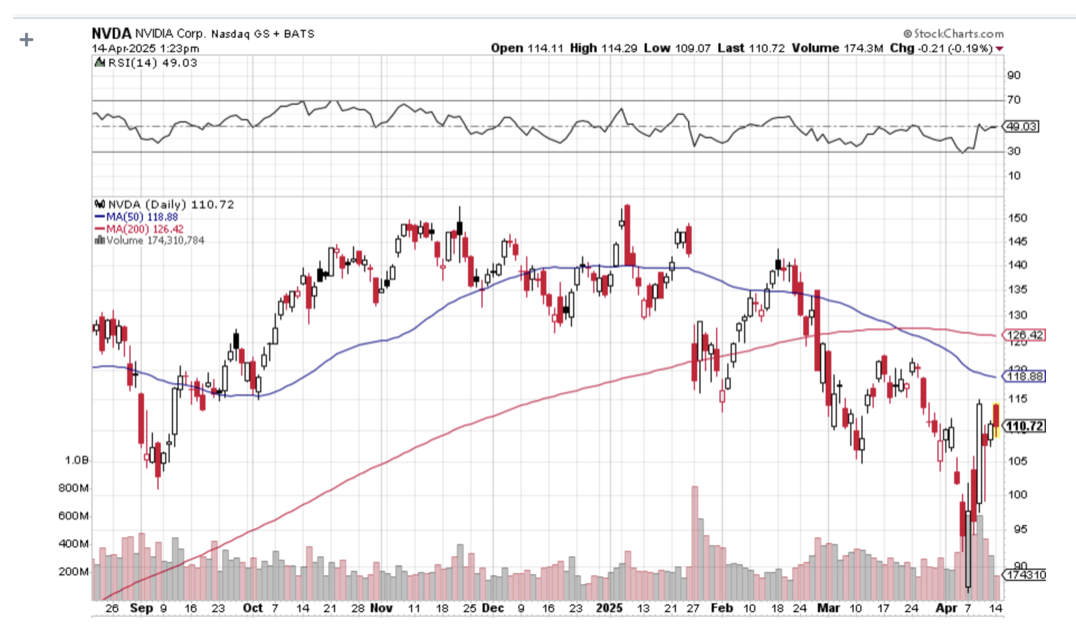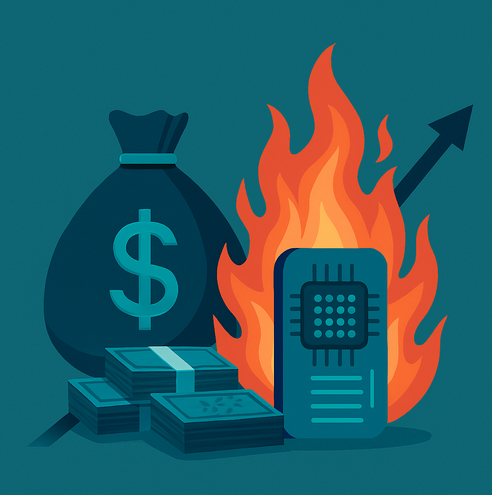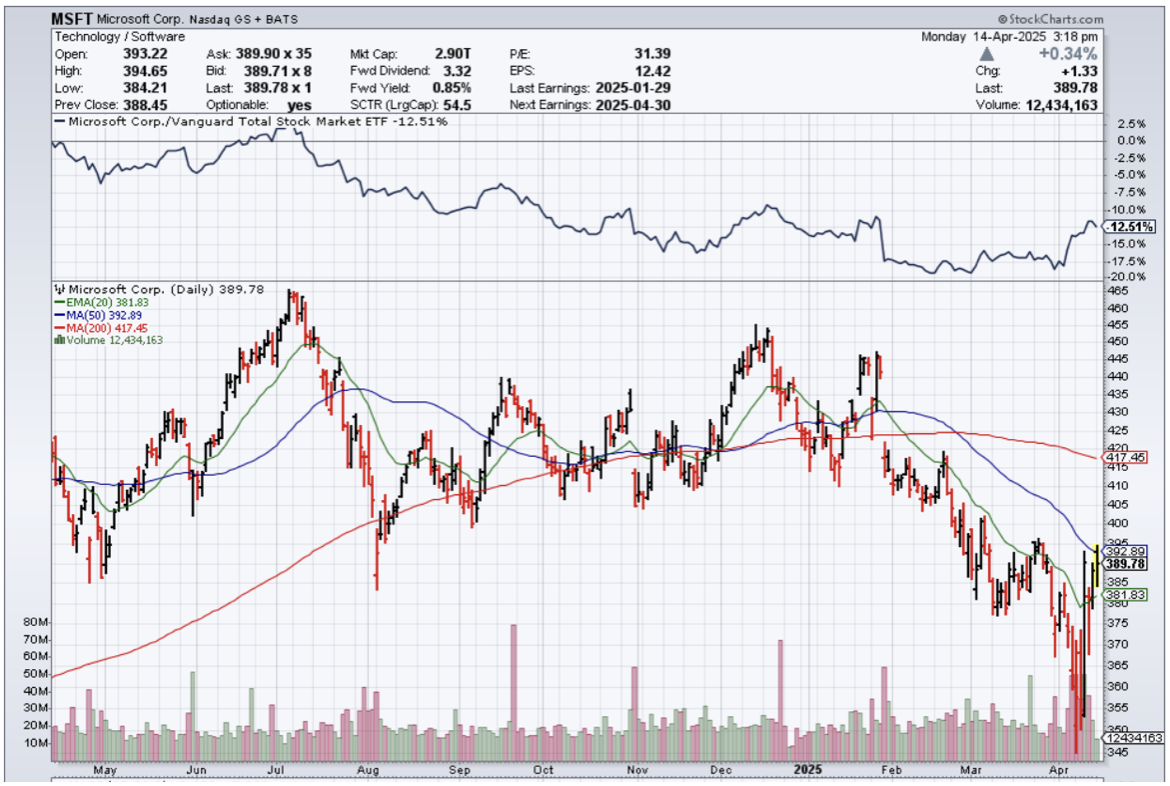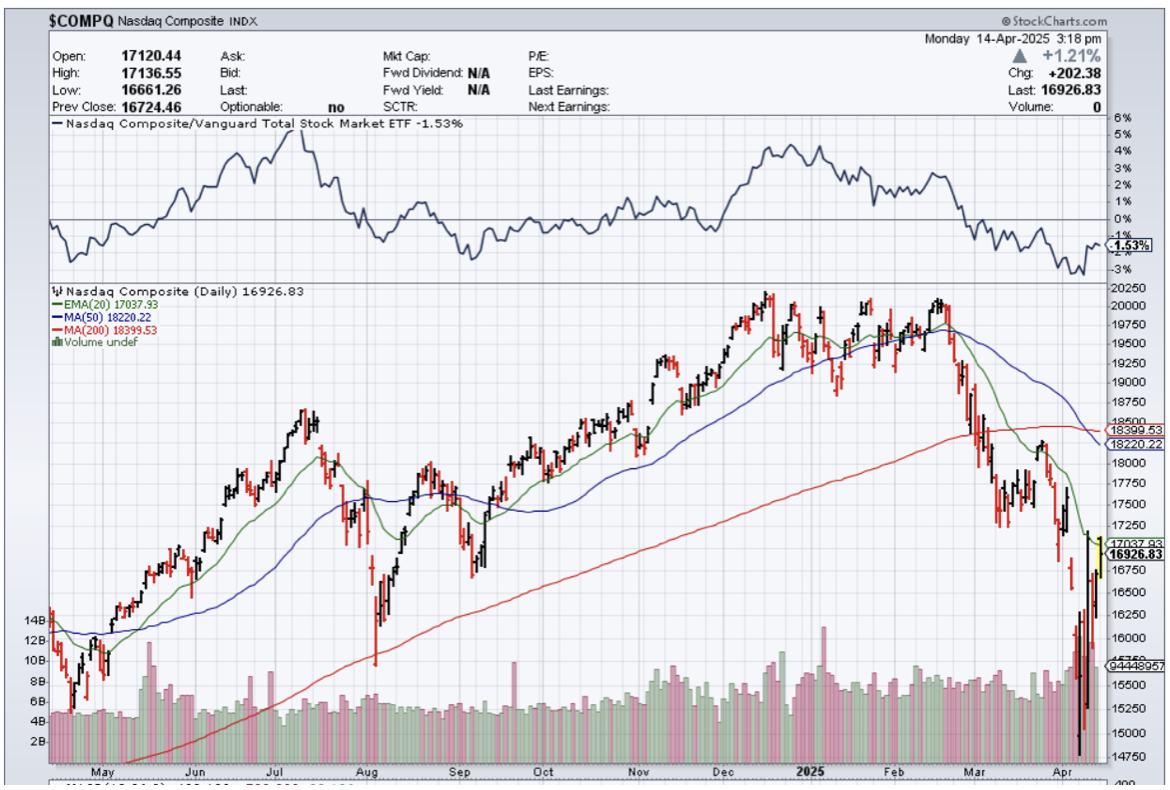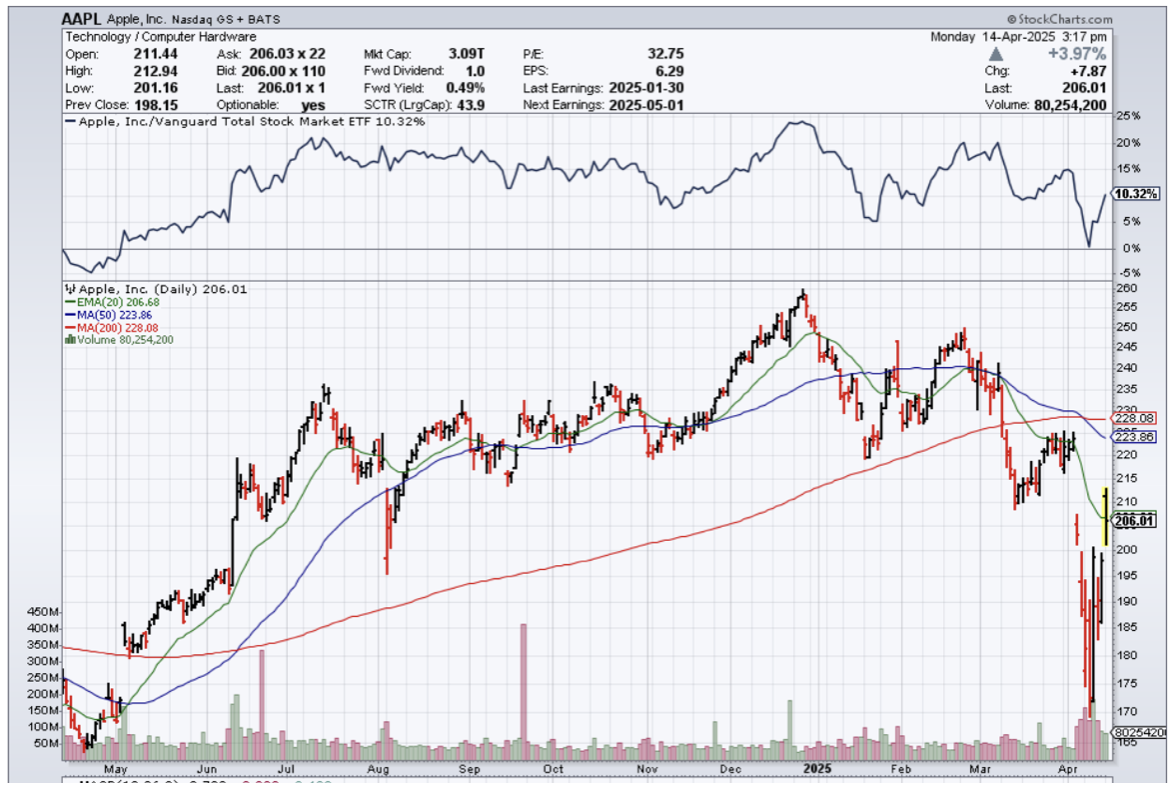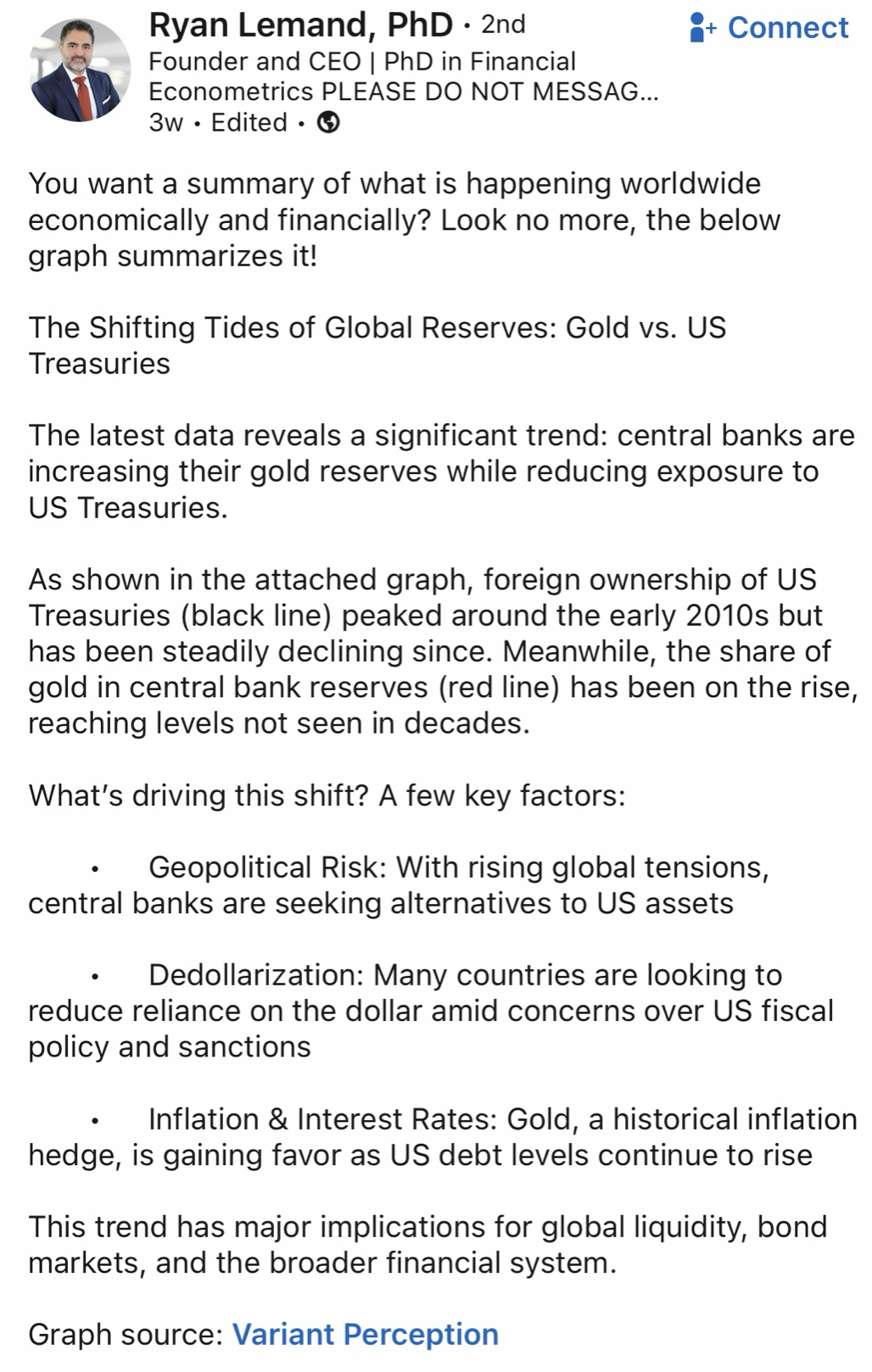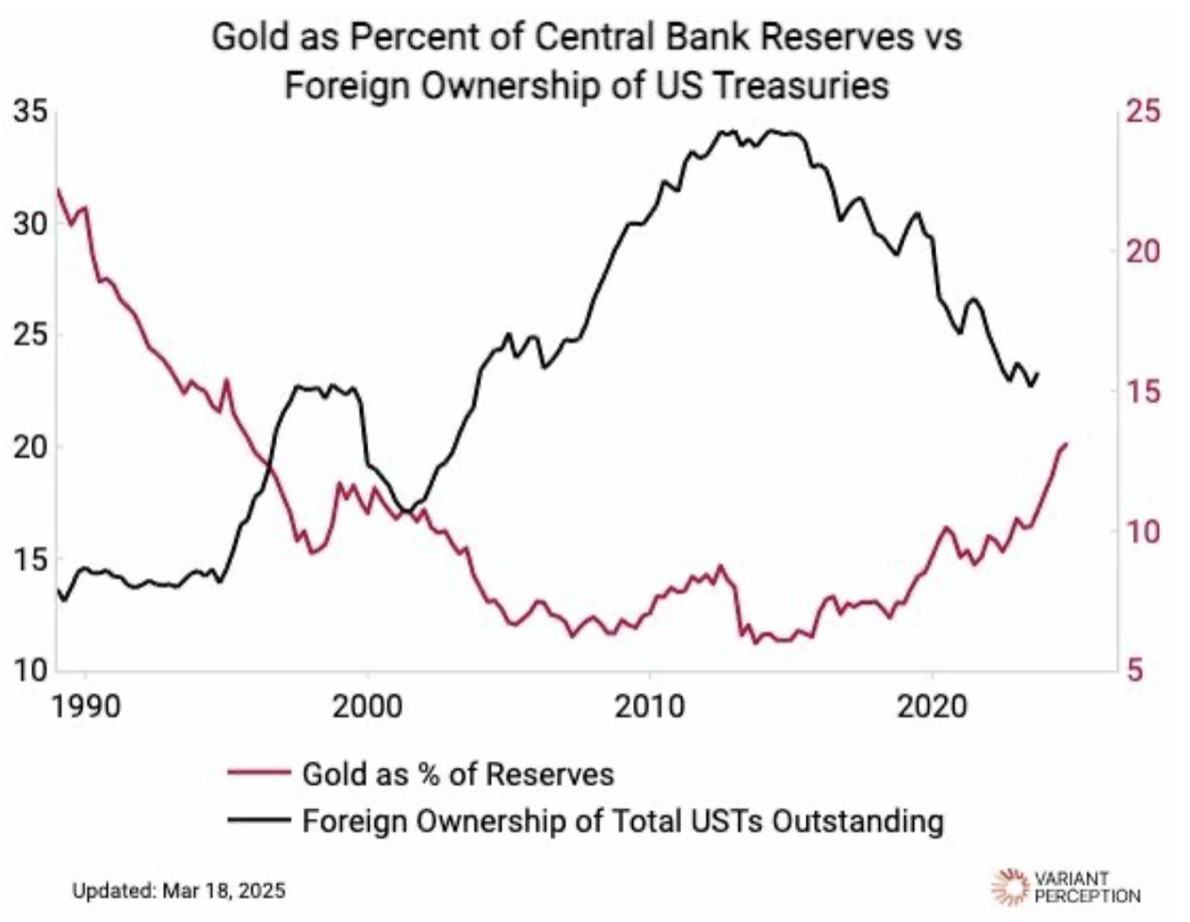When John identifies a strategic exit point, he will send you an alert with specific trade information as to what security to sell, when to sell it, and at what price. Most often, it will be to TAKE PROFITS, but on rare occasions, it will be to exercise a STOP LOSS at a predetermined price to adhere to strict risk management discipline. Read more
Mad Hedge Biotech and Healthcare Letter
April 15, 2025
Fiat Lux
Featured Trade:
(THE WEIGHT OF EXPECTATIONS)
(LLY), (NVO)
You know that feeling when you've found the perfect restaurant? The food is exquisite, the atmosphere divine, and then you get the bill—and suddenly you're calculating if selling a kidney is a viable financial strategy.
That's essentially my relationship with Eli Lilly (LLY) right now. Phenomenal company, stellar performance, price tag that makes my wallet weep.
I've had a complicated romance with this pharmaceutical juggernaut. Back in my hedge fund days, I learned that timing is everything with pharma stocks. It's like catching the perfect wave off Malibu – ride it too early, you're just splashing in the shallows; too late, and you're eating sand.
When I first spotted Lilly in June 2023, it was set up beautifully. Shares rocketed 56.2% before I downgraded to a 'hold' last February, while the broader market trudged along with a mere 12.3% gain.
Since then, the stock has performed almost exactly as predicted—just a 0.2% gain compared to the S&P 500's 1.33%. More recently, it's dropped 6.9% since January, looking positively rosy next to the broader market's 12.2% decline.
The company's fourth-quarter results read like a biotech investor's fantasy novel. Revenue soared 44.7% year-over-year to $13.53 billion, driven by its dynamic weight-loss duo.
Mounjaro's sales jumped 60.1% to $3.53 billion, while Zepbound exploded from $175.8 million to a jaw-dropping $1.91 billion.
I've watched patients in clinical trials shed substantial weight on these medications—one of my research contacts dropped 43.4 pounds since starting treatment—and I can tell you these drugs are creating waves not just in waistlines but across the entire healthcare sector.
Other stars in Lilly's portfolio include Verzenio for breast cancer (up to $1.56 billion from $1.15 billion), Jardiance for diabetes (climbing to $1.20 billion), and solid gains from Taltz and Humalog.
Only Trulicity disappointed, watching its revenue tumble from $1.67 billion to $1.25 billion—predictably cannibalized by Lilly's newer weight-loss offerings. It's like watching your reliable sedan gathering dust after buying a Tesla.
With this revenue bonanza, profits naturally skyrocketed. Net income more than doubled to $4.41 billion, adjusted profits surged to $4.81 billion, and operating cash flow swung from negative $311.9 million to positive $2.47 billion.
In my decades of following pharmaceutical stocks from Tokyo to Wall Street, I've rarely seen a quarterly performance this impressive. If Lilly were a student, it would be the annoying one breaking the curve for everyone else.
Looking ahead, management projects 2025 revenue between $58-61 billion (a 32.1% increase at midpoint) and adjusted EPS between $22.50-24.
For the upcoming Q1 report on May 1st, analysts anticipate revenue of $12.77 billion (45.6% higher year-over-year) and EPS of $4.70 (nearly double last year's $2.48).
So with all this financial wizardry, why maintain a 'hold'? One word: valuation.
Even using 2025's projected figures, Lilly trades at eye-watering multiples: forward P/E of 33.3, price-to-cash-flow of 27.6, and EV/EBITDA of 21.2.
For context, pharmaceutical peers trade significantly lower. Novo Nordisk (NVO), perhaps the most comparable given its similar weight-loss market success, trades at a P/E of 19.0, price-to-cash-flow of 15.9, and EV/EBITDA of 14.6.
It's like comparing Manhattan real estate to Cleveland—both might be perfectly fine places to live, but one demands a significant premium.
Don't mistake my caution for bearishness. Lilly's product pipeline is robust, highlighted by Retatrutide, which has shown even more impressive weight-loss results—patients lost an average of 24.2% of their body weight (58 pounds) in clinical trials.
The company is also expanding its manufacturing footprint with four new US sites, creating 3,000 permanent jobs. It's acquiring promising treatments like Scorpion Therapeutics' STX-478 for $2.5 billion upfront.
Meanwhile, shareholders enjoyed $4.7 billion in dividends and $2.5 billion in buybacks last year, with a new $15 billion repurchase program and a 15% dividend increase announced for 2025.
I'd compare Lilly's stock to its own weight-loss drugs: remarkably effective, potentially life-changing, but priced at a level that makes you question whether the benefits justify the cost.
If May's results blast past expectations with raised guidance, I'll happily reconsider. Until then, I'm maintaining my 'hold'—admiring from across the room, but not ready to propose just yet.
Global Market Comments
April 15, 2025
Fiat Lux
Featured Trade:
(HOW TO HANDLE THE THURSDAY, APRIL 17 OPTIONS EXPIRATION)
Followers of the Mad Hedge Fund Trader alert service have the good fortune to own FIVE in-the-money options positions that expire on Thursday, April 17, and I just want to explain to the newbies how to best maximize their profits.
These involve the:
Risk On
(COST) 4/$840-$850 call spread 10.00%
(TSLA) 4/$160/$170 put spread 10.00%
(NFLX) 4/$800-$810 call spread 10.00%
(NVDA) 4/$70-$75 call spread 10.00%
Risk Off
(MSTR) 4/$340-$350 put spread -10.00%
Provided that we don’t have a monster move in the market in three trading days, these positions should expire at their maximum profit points.
So far, so good.
I’ll take the example of the (NVDA) 4/$70-$75 call spread.
Your profit can be calculated as follows:
Profit: $5.00 expiration value - $4.50 cost = $0.50 net profit
(25 contracts X 100 contracts per option X $0.50 profit per option)
= $1,250 or 11.11% in 9 trading days.
Many of you have already emailed me asking what to do with these winning positions.
The answer is very simple. You take your left hand, grab your right wrist, pull it behind your neck, and pat yourself on the back for a job well done.
You don’t have to do anything.
Your broker (are they still called that?) will automatically use your long position to cover your short position, canceling out the total holdings.
The entire profit will be credited to your account on Monday morning, April 21, and the margin freed up.
Some firms charge you a modest $10 or $15 fee for performing this service.
If you don’t see the cash show up in your account on Monday, get on the blower immediately and find it.
Although the expiration process is now supposed to be fully automated, occasionally, machines do make mistakes. Better to sort out any confusion before losses ensue.
If you want to wimp out and close the position before the expiration, it may be expensive to do so. You can probably unload those pennies below their maximum expiration value.
Keep in mind that the liquidity in the options market understandably disappears and the spreads substantially widen when a security has only hours or minutes until expiration on Thursday. So, if you plan to exit, do so well before the final expiration at the Thursday market close.
This is known in the trade as the “expiration risk.”
One way or the other, I’m sure you’ll do OK, as long as I am looking over your shoulder, as I will always. Think of me as your trading guardian angel.
I am going to hang back and wait for good entry points before jumping back in. It’s all about keeping that “Buy low, sell high” thing going.
I’m looking to cherry-pick my new positions going into the next quarter's end.
Take your winnings and go out and buy yourself a well-earned dinner.
Well done, and on to the next trade.
You Can’t Do Enough Research
(NVDA), (MSFT), (GOOG),(AMZN)
You know what's crazy? A company that burns $5 billion a year in computing costs getting valued at $300 billion.
Yet here we are. OpenAI just closed a monster funding round, raising up to $40 billion from investors including SoftBank Group at a staggering $300 billion valuation. That's nearly double what the company was valued at just six months ago.
I've seen this movie before, both as a hedge fund manager and while dodging Russian artillery in Ukraine. Euphoria rarely ends well, whether in markets or on battlefields.
The company behind ChatGPT has become the darling of the investment world despite the fact that it won't be profitable until 2029, according to Sam Altman's own projections. 2029! That's four years and several AI generations from now.
This is a company that expects to generate $13 billion in revenue this year, which sounds impressive until you realize they'll likely spend more than that on computing costs alone. In fact, in 2024, OpenAI reported revenue of around $4 billion while racking up $5 billion in computing costs just to train and run their models.
When I was running hedge funds in the 1990s, we had a technical term for businesses like this: money pits.
Let's dive deeper into these numbers. Over 90% of OpenAI's 500 million users worldwide pay absolutely nothing to use the service. In 2025, the company projects that just under 5% of users might pay the $20-a-month charge to access their more advanced AI models. That would generate about $5.5 billion. Another 0.3% might opt for ChatGPT Pro, contributing another $3.6 billion.
The trouble is that a whopping 70% of OpenAI's revenue comes with expenses that may keep rising faster than the top line. According to reporting from The Information, by the end of the decade, OpenAI will still probably spend 60% to 80% of its annual revenue just to train or run its models.
Meanwhile, competition is heating up. OpenAI's market share of enterprise large language models (LLMs) has already fallen to 34% in 2024 from 50% a year ago, according to Menlo Ventures data. Companies like Anthropic, Meta, Google, and Mistral AI are eating into their lead.
And there's another problem: intense pricing competition. As companies like Mistral AI and Anthropic offer competitive alternatives, OpenAI's ability to charge premium prices for its API services is under pressure.
During my decades reporting from Asia, I witnessed countless companies with "revolutionary technology" that eventually became commoditized faster than anyone expected. When I covered the Japanese semiconductor industry in the 1970s, companies that once had seemingly unassailable leads saw their margins evaporate within years.
So why are investors like SoftBank's Masayoshi Son so eager to pour billions into this cash-burning machine? The answer lies in the potential of achieving artificial general intelligence (AGI) – AI systems that can perform any intellectual task that a human can. If OpenAI succeeds in developing AGI, the economic rewards could be incalculable.
In a fascinating twist, OpenAI just made its first cybersecurity investment, putting money into a startup called Cosmic. This signals a strategic expansion beyond its core AI development work. Smart move, considering that as AI becomes more ubiquitous, securing it becomes increasingly critical.
Additionally, there are rumors that OpenAI may release an open-source model, which would be a significant shift in strategy. This could be a play to expand their ecosystem and solidify their position as the standard-bearer in AI development.
For investors trying to play the AI revolution, the question becomes: is it better to invest directly in pure AI plays like OpenAI (if and when it goes public), or in the companies that actually make money from the AI boom today?
The smartest money might be in NVIDIA (NVDA), which supplies the crucial GPUs that power AI development. Despite trading at seemingly high multiples, NVIDIA continues to see explosive growth in data center revenue as AI development accelerates. Even with competition from AMD and Intel, NVIDIA maintains a commanding lead in AI chip technology.
Microsoft (MSFT) provides another interesting angle, given its deep partnership with OpenAI. The company has exclusive rights to commercialize OpenAI's technology and has already integrated ChatGPT capabilities across its product line, from Bing to Office 365.
For those looking at pure AI plays beyond the giants, Anthropic (backed by Google (GOOG) and Amazon (AMZN)) and Mistral AI represent interesting alternatives to OpenAI, though they remain private for now.
Is AI revolutionary? Absolutely. Are most AI companies going to make money anytime soon? Don't bet your retirement on it. For OpenAI to hit Altman's projected $125 billion revenue target by 2029, they need to grow 10-fold while dramatically shifting from money-losing free users to enterprise clients that actually pay the bills.
That's a tall order, even for a company with seemingly unlimited access to capital. I've witnessed too many "guaranteed successes" implode over my five decades in the markets. After covering countless bubbles from Tokyo to Silicon Valley, I've learned that eventually, cash flow matters. Always.
If I were allocating capital today, I'd be putting my money on companies with proven ability to convert AI hype into actual profits. Let others chase the AGI dream while you count real returns.
At this late stage in my life, I've learned that what seems inevitable rarely is, and what looks impossible often becomes routine within years. Will OpenAI justify its $300 billion valuation? Perhaps. But at these prices, investors are paying for perfection when the company hasn't even figured out a sustainable business model.
That's not investing – that's speculation.
And if there's one thing my bullet wound from Ukraine taught me, it's that life's too short for bad bets.
Mad Hedge Technology Letter
April 14, 2025
Fiat Lux
Featured Trade:
(BIG TECH ANXIOUS FOR CLARITY)
(MSFT), (AAPL), ($COMPQ)
At this pace, nobody knows what the government policies will look like, and if this doesn’t change, the uncertainty will bleed into lower tech stocks ($COMPQ).
Tech has had a hard short-term run, and the unstable backdrop will lead to investors pausing on big tech stock purchases.
Tech businesses are also reigning in their investment spend, waiting to see what happens.
Microsoft (MSFT) has already made announcements on pausing its AI database build out and that has really chilled momentum in the wider AI trade.
If this electronics exemption announced Friday night is true, it represents an important temporary win for Apple (AAPL) and other China-dependent technology giants.
News reports that producing the iPhone in America could cause the price of a new iPhone to double send shockwaves throughout the investment community.
The federal government might have to pull back their aggressive policies when factoring in surging yield in interest rates and a short-term collapse of the dollar.
The president said these products are simply moving to a different tariff "bucket," telling reporters that a separate rate for semiconductor tariffs will be announced over this week.
Trump added that his goal is to "uncomplicate" things by moving production to the US but that companies will have a say.
Either way, the fact remains that Trump has offered at least a temporary boost to companies with close links to China, and investors are responding by sending stocks of directly impacted companies like Apple and Dell (DELL) higher this morning.
These technology companies' goods are still subject to 20% blanket tariffs on China over fentanyl and likely face legacy sector-specific tariffs from Trump 1.0 and the Biden era, but they are now able to sidestep the lion's share of the 145% rate that is now in place for other goods.
The move is also a significant walk back of Trump's overall tariff plans, with electronics representing the top exports from China to the US.
This weekend's move means the overall effective tariff rate on US imports is now 22% — down from 27% just last week.
The smaller the tech company is, the bigger they are impacted with this whipsawing strategy of threatening all your trading partners.
Larger companies certainly have more options than small businesses to dodge the tariffs due to their worldwide networks and political relationships.
Apple, as one example, also gained attention in recent days for reportedly chartering cargo flights to move as many as 1.5 million iPhones to the United States from India quickly to get ahead of tariffs there.
Tech shares are pricing in nothing positive emerging in the short-term.
Management doesn’t want to get burned by moving in one direction, only to see a product get wiped out due to high costs.
It is hard to change the issue of how the U.S. relocated the supply chain to cheaper foreign countries.
The consensus of higher prices comes after Americans have been dealing with uncontrollable inflation since 2020.
The extra price increase preceding Trump’s tariff crusade has consumers in a hole.
Even compared to 2024, I don’t see where the incremental dollar comes into the tech sector when margins are being squeezed in real time.
At best, we could experience a bear market or choppy sideways price action to reflect a tougher environment for doing tech businesses, whether it is streaming, software, hardware of EVs.
When John identifies a strategic exit point, he will send you an alert with specific trade information as to what security to sell, when to sell it, and at what price. Most often, it will be to TAKE PROFITS, but, on rare occasions, it will be to exercise a STOP LOSS at a predetermined price to adhere to strict risk management discipline. Read more
(VOLATILITY IS A WELCOME CREATOR OF OPPORTUNITY)
April 14, 2025
Hello everyone
WEEK AHEAD CALENDAR
Monday, April 14
12:00 p.m. US Fed Speakers
Earnings: Goldman Sachs, M&T Bank
Tuesday, April 15
8:30 a.m. Export Price Index (March)
8:30 a.m. Import Price Index (March)
8:30 a.m. Empire State Index (April)
8:30 a.m. Canada Inflation Rate
Previous: 2.6%
Forecast: 2.8%
Earnings: J.B. Hunt Transport Services, United Airlines, Omnicom Group, Citigroup, Bank of America, PNC Financial Services Group, Johnson & Johnson
Wednesday, April 16
8:30 a.m. Retail Sales (March)
9:15 a.m. Capacity Utilization (March)
9:15 a.m. Industrial Production (March)
9:15 a.m. Manufacturing Production (March)
9:45 a.m. Canada Rate Decision
Previous: 2.75%
Forecast: 2.75%
10:00 a.m. Business Inventories (February)
10:00 a.m. NAHB Housing Market (April)
Earnings: Kinder Morgan, CSX, Travelers, U.S. Bancorp, Citizens Financial Group, Prologis, Abbott Laboratories, Progressive
Thursday, April 17
8:15 a.m. ECB Rate Decision
Previous: 2.5%
Forecast: 2.25%
8:30 a.m. Continuing Jobless Claims (04/05)
8:30 a.m. Housing Starts (March)
8:30 a.m. Initial Claims (04/12)
8:30 a.m. Philadelphia Fed Index (April)
Earnings: Netflix, Truist Financial, State Street, American Express, Snap-On, KeyCorp, Fifth Third Bancorp, Regions Financial, United Health Group, Charles Schwab, Huntington Bancshares, D.R. Horton, Marsh & McLennan Cos.
Friday, April 18
NYSE closed for Good Friday holiday.
Volatility – Make It Thy Friend
Are you enjoying The Ride?
Volatility is expected to continue into this week.
Uncertainty is the dark cloud hanging over the world due to the Trump administration’s constant policy backflips and sidesteps over trade tariffs – from day to day we are uncertain which countries are exempt, or pay a lower tariff, which goods are exempt and how long the pause will be on tariffs and how long tariffs will be enforced.
It's all very chaotic and leaves companies completely undone in trying to understand their position in relation to earnings in the future.
It’s futile currently; there is no firm ground anywhere.
But this volatility can create valuable opportunities.
Stocks are on sale. And the markdowns will be here for a while – but not forever.
The latest change to Trump’s trade tariffs circles around electronics imported from China – iPhones, computers, and computer chips have been temporarily exempted from tariffs. We don’t know how long this will last. But tech stocks are expected to surge when the market opens on Monday.
It's interesting to note the resilience of Bitcoin, which has held up remarkably well during the tumultuous movements that have taken place on global markets. It’s now being seen as a hedge and a distinct asset class.
MARKET UPDATE
S&P500
The index has bounced nicely from the April 7 low at 4835. Though this market is obviously oversold, there is still no evidence of even a shorter-term low in place. And this suggests weakness back toward the 4800-support area.
Resistance: $5480/$5595
Support: $5110/$4915
GOLD
Gold has rallied to another all-time high, reaching $3245. There is no confirmation of a top yet, but the market is certainly overbought, raising risk.
Resistance: $3240
Support: $$3160/$3100/$2975
BITCOIN
Bitcoin did push down into the low $70’s before quickly bouncing. Eventual new highs are favoured. Basing takes time and even though we have seen a nice move up, there is still a risk more basing will take place, and we may even see a slight new low before a more significant upside is seen.
Resistance: $85.3/$85.8 (If we can close above these levels – a final low may be in place).
Further resistance levels above include $ 88.6/$ 88.6/$92.1
Support: $79.5/$74.4/$73.3
HISTORY CORNER
On April 14
SOMETHING TO THINK ABOUT
Mohamed El-Erian expresses the notion that Economic and Market Stability Hinges on These Questions
- Are the “wins” from gaining concessions from the more than 70 countries eager to negotiate with the US sufficient to calm markets and restore the economy’s footing?
- Are there pathways to constructive negotiations between China and the US that do not involve a significant loss of face for either party?
- Can the administration and the Fed signal the existence of credible bazooka-style circuit breakers that would be quickly activated with limited collateral damage should financial markets malfunction?
- How much patience will holders of American assets, particularly foreign holders, have in the face of the threat of Chinese selling?
- How much of the damage to America’s global standing and reputation is already too close to the line that separates worrisome from irreversible?
- How hard is it to persuade US households and companies to maintain their spending during such a time of heightened uncertainty?
- How quickly can the US counter China’s stepped-up efforts to present itself to other countries as a responsible and dependable partner for trade, technology, institutional collaboration, and, eventually, a collective payments system?
American policymakers need satisfactory answers to these questions if they are to successfully navigate the Trump administration on its desired path.
Trump’s goals –
Fairer trading system
More enabled private sector
A slimmed down and more efficient public system
A more favourable debt dynamic
“The stock market is the only market where things go on sale and all the customers run out of the store.”
Cullen Roche
Cheers
Jacquie
Legal Disclaimer
There is a very high degree of risk involved in trading. Past results are not indicative of future returns. MadHedgeFundTrader.com and all individuals affiliated with this site assume no responsibilities for your trading and investment results. The indicators, strategies, columns, articles and all other features are for educational purposes only and should not be construed as investment advice. Information for futures trading observations are obtained from sources believed to be reliable, but we do not warrant its completeness or accuracy, or warrant any results from the use of the information. Your use of the trading observations is entirely at your own risk and it is your sole responsibility to evaluate the accuracy, completeness and usefulness of the information. You must assess the risk of any trade with your broker and make your own independent decisions regarding any securities mentioned herein. Affiliates of MadHedgeFundTrader.com may have a position or effect transactions in the securities described herein (or options thereon) and/or otherwise employ trading strategies that may be consistent or inconsistent with the provided strategies.






